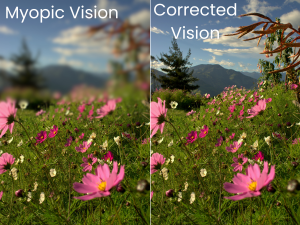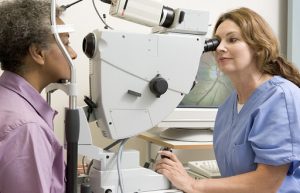-
See the Difference: Save $1,000 on LASIK , Find More
*Must mention this promotion and be treated in June of 2025 to qualify. $1,000 off for both eyes on standard Wavelight price, $500 off for one eye. Cannot be combined with any other offers.
Nearsightedness 101: What is Myopia and How to Fix it?
In the world of eyeballs, there are almost as many terms for conditions as there are hairs on your head. Keeping them all straight can be challenging, but we’re here to help make sense of it all. Today, we’re exploring one of the most common eye conditions in the optometry field: Myopia- AKA short-sightedness or near-sightedness. If you have this condition, you probably already know something is “off” with your vision, but you might not know exactly what that is.
Keep reading to learn what nearsightedness is, what causes it, and the best way to correct this common refractive error.

What Does Nearsightedness Mean? What is Myopia?
Myopia (the medical term for nearsightedness) is a condition where you can see objects close-up clearly, but you have difficulty seeing things that are off in the distance. This refractive error is caused by your cornea being too curved- or too elongated- resulting in the light focusing in front of the retina instead of ON the retina.
Nearsightedness is extremely common, so you’re not alone if you’re experiencing this vision complication. In fact, over 3 million people are diagnosed with nearsightedness each year in the U.S. alone.
What Causes Nearsightedness?
The exact cause of nearsightedness is unknown, but there’s plenty of evidence suggesting that this condition is hereditary. For example, if one or both of your parents are nearsighted, it’s highly likely that you will experience this as well- or at least the conditions will be ripe for you to develop it yourself.
But even though nearsightedness can be inherited, the actual development of this condition may be greatly affected by how you’re physically using your eyes on a daily basis. If you spend long hours working at a computer exposed to blue light, read for extended periods of time, or do other prolonged activities with your eyes, you might be more likely to develop myopia or nearsightedness.
Additionally, if you do an excessive amount of close-up work, you might experience a false or “pseudo” myopia. This is caused by overworking the focusing mechanism in your eyes. After long periods of up-close work, your eyes are unable to refocus to see clearly in the distance. Oftentimes this goes away after taking a break to let your eyes rest.
Symptoms of nearsightedness can also be a sign of variations in blood sugar levels in people with diabetes, or it may be an early indication that you’re developing a cataract.

Symptoms of Nearsightedness
If you’re nearsighted, you’ll probably find yourself squinting to see things far away. You might even find that squinting doesn’t help at all; with advanced stages of myopia, you may not be able to see anything at all without your glasses or contacts.
If you’re struggling with myopia, you probably already know it. However, if you’re a unsure of what your specific vision issue is, here are some of the main symptoms of nearsightedness:
- Blurry vision when looking at distant objects
- Constant headaches
- Difficulty seeing while driving, especially during the night
- Squinting or partially closing your eyes to “see better”
- Eye strain or fatigue
Learn More about Myopia Symptoms
Can You Avoid Nearsightedness?
As far as we know, it’s not possible to prevent nearsightedness. However, according to the Mayo Clinic, studies show that you can potentially slow down its development and catch it early on.
To help protect your eyes:
- Opt for yearly eye exams
- Wear sunglasses with ultraviolet (UV) radiation protection
- Use protective eyewear when participating in risky activities
- When you’re working at a computer, give your eyes regular breaks
- Manage any chronic health conditions, such as high blood pressure or diabetes
- Consume foods that support eye health
- Avoid smoking
How to Diagnose Nearsightedness
It’s always a good idea to talk to your eye doctor if you’re having difficulty seeing- but especially if you think you might be experiencing nearsightedness.
When you go in for your eye exam, tell your doctor what symptoms you’re having, what your vision challenges are, and explain any relevant family history. Your eye doctor can diagnose nearsightedness by performing a basic exam, which includes a refraction assessment and an eye health exam.
After a professional diagnosis, you can work with your doctor to formulate a plan of action. You have options!

How Do You Correct Nearsightedness?
When it comes to correcting nearsightedness, you ultimately have three options; prescription glasses, contact lenses, and refractive surgery.
Eyeglasses help make up for the irregular curve of your cornea by shifting the focus of light as it enters your eye. If you’re nearsighted, you might have to wear corrective lenses all the time, or just for isolated activities, like driving or sitting in a classroom.
Contact lenses give you a slightly wider field of corrected vision than glasses do, and they offer a bit more versatility (instead of wrestling with glasses all day). However, there are many risks associated with contact lenses, including infections, pink eye and corneal scratches.
Contacts can present several risks to the overall health of your eyes, which is why so many people turn to LASIK surgery to correct their farsightedness.
Refractive surgery offers an easy and permanent solution for nearsightedness. Also referred to as LASIK laser eye surgery, this procedure painlessly reshapes the cornea to properly focus light onto your retina. Most patients who undergo this procedure find that they no longer need to wear their glasses or contacts afterwards and experience the relief of 20/20 vision.
Learn More about Myopia Treatments
Does LASIK Treat Nearsightedness?
Are you wondering: “does LASIK treat nearsightedness?” If so, the answer is: YES.
LASIK is the most commonly performed laser eye surgery for refractive errors (like nearsightedness, farsightedness and astigmatism). Our doctors only perform bladeless LASIK and PRK surgery, which means that a special laser- as well as topical anaesthetic numbing drops- are used for these procedures, so you won’t feel anything besides a tiny bit of pressure.
During the LASIK procedure, a tiny flap is created in the cornea, which is folded back to give the laser deeper access to the corneal tissue. Some of this tissue is then removed, making the eye more thin and allowing the light to focus on the back of the eye, instead. The flap is then replaced and the procedure is finished!
With laser eye surgery, both of your eyes are optimized for distance- allowing you to see clearly without needing to use glasses or contacts. In a study published in the Journal of Refractive Surgery, they found that 95% of patients who had chosen LASIK had 20/20 vision four years later, without the use of glasses or contacts. In the 20 years since LASIK has been around, doctors in the U.S. have performed more than 19 million of these procedures.

From the very beginning, LasikPlus has been proud to partner with some of the nation’s most experienced surgeons, and has invested in the most advanced technology to provide you with the best experience possible.
At LasikPlus, you can take comfort in knowing that you are putting your vision in the most capable hands.
The Final Word on Nearsightedness
When it comes to nearsightedness and myopia, it’s helpful to go see your eye doctor yearly for a comprehensive eye exam. They can help you detect any issues and help you address them as early as possible.
Nearsightedness can be treated easily and effectively with LASIK surgery. If you would like to learn more about PRK or LASIK for nearsightedness, call 1.866.755.2026 or book your free consultation with us today!
-
City Match
Austin, Texas
-
City Match
Independence, Ohio
-
City Match
Providence, North Carolina
-
City Match
St. Paul, Minnesota
-
City Match
Oak Brook, Illinois
-
City Match
Westchester, Illinois
-
City Match
Tinley Park, Illinois
-
City Match
Leawood, Kansas
-
City Match
Olathe, Kansas
-
City Match
Manhattan, Kansas
-
City Match
Columbus, Ohio
-
City Match
Houston, Texas
-
City Match
Houston, Texas
-
City Match
Houston, Texas
-
City Match
Houston, Texas
-
City Match
Houston, Texas
-
City Match
Atlanta, Georgia
-
City Match
Atlanta, Georgia
-
City Match
Dallas, Texas
-
City Match
Dallas, Texas
-
City Match
Birmingham, Alabama
-
City Match
Birmingham, Alabama
-
City Match
Norman, Oklahoma
-
City Match
Durham, North Carolina
-
City Match
Philadelphia, Pennsylvania
-
City Match
Athens, Ohio
-
City Match
Lewis Center, Ohio
-
City Match
Delaware, Ohio
-
City Match
Columbus, Ohio
-
City Match
Columbus, Ohio
-
City Match
Oak Brook, Illinois
-
City Match
Indianapolis, Indiana
-
City Match
Indianapolis, Indiana
-
City Match
Indianapolis, Indiana
-
City Match
Indianapolis, Indiana
-
City Match
Indianapolis, Indiana
-
City Match
Las Vegas, Nevada
-
City Match
Houston, Texas
-
City Match
Eau Claire, Wisconsin
-
City Match
Oshkosh, Wisconsin
-
City Match
Kenosha, Wisconsin
-
City Match
Indianapolis, Indiana
-
City Match
Indianapolis, Indiana
-
City Match
Vancouver, Washington
-
City Match
Boulder , Colorado
-
City Match
Aurora , Colorado
-
City Match
Colorado Springs, Colorado
-
City Match
Santa Fe, New Mexico
-
City Match
Gainesville, Florida
-
City Match
St. Augustine, Florida
-
City Match
Evanston, Illinois
-
City Match
Greenwood , Indiana
-
City Match
Waco, Texas
-
City Match
Arlington, Texas
-
City Match
Loudoun County, Virginia
-
City Match
Sarasota , Florida
-
City Match
Austin, Texas
-
City Match
Austin, Texas
-
City Match
Austin, Texas
-
City Match
Austin, Texas
-
City Match
Austin, Texas
-
City Match
Jacksonville, Florida
-
City Match
Plantation, Florida
-
City Match
Tampa, Florida
-
City Match
Altamonte Springs, Florida
-
City Match
Saratoga Springs, New York
-
City Match
Atlanta, Georgia
-
City Match
Atlanta, Georgia
-
City Match
Atlanta, Georgia
-
City Match
Hartford, Connecticut
-
City Match
New York, New York
-
City Match
Las Vegas, Nevada
-
City Match
Scottsdale, Arizona
-
City Match
Scottsdale, New York
-
City Match
Scottsdale, Arizona
-
City Match
Houston, Texas
-
City Match
Houston, Texas
-
City Match
Houston, Texas
-
City Match
Houston, Texas
-
City Match
Mesa, Arizona
-
City Match
Sandy, Utah
-
City Match
Ogden, Utah
-
City Match
Houston, Texas
-
City Match
Provo, Utah
-
City Match
Brooklyn, New York
-
City Match
Brooklyn, New York
-
City Match
Brooklyn, New York
-
City Match
New Jersey, New Jersey
-
City Match
New York, New York
-
City Match
New Jersey, New Jersey
-
City Match
Wilmington, Pennsylvania
-
City Match
New Jersey, New Jersey
-
City Match
Lancaster, Pennsylvania
-
City Match
Paramus, New Jersey
-
City Match
York, Pennsylvania
-
City Match
Bozeman, Idaho
-
City Match
Nampa, Idaho
-
City Match
Salem, Oregon
-
City Match
Renton, Washington
-
City Match
Renton, Washington
-
City Match
Cleveland , Ohio
-
City Match
Columbia, Maryland
-
City Match
Renton, Washington
-
City Match
Florida, Florida
-
City Match
Florida, Florida
-
City Match
Overland Park, Kansas
-
City Match
Topeka, Kansas
-
City Match
Arizona, Arizona
-
City Match
Washington, Washington
-
City Match
Garden City, New York
-
City Match
Madison, Wisconsin
-
City Match
Boca Raton, Florida
-
City Match
New York, New York
-
City Match
Tucson, Arizona
-
City Match
Charlottesville, Virginia
-
City Match
Amherst, New York
-
City Match
Billings, Montana
-
City Match
Southfield, Michigan
-
City Match
Virginia Beach, Virginia
-
City Match
El Paso, Texas
-
City Match
Syracuse, New York
-
City Match
West Palm Beach, Florida
-
City Match
Greenville, South Carolina
-
City Match
Durham, North Carolina
-
City Match
Grand Rapids, Michigan
-
City Match
Greensboro, North Carolina
-
City Match
Mount Pleasant, South Carolina
-
City Match
Birmingham, Alabama
-
City Match
Las Vegas, Nevada
-
City Match
Memphis, Tennessee
-
City Match
Metairie, Louisiana
-
City Match
Little Rock, Arkansas
-
City Match
West Fargo, North Dakota
-
City Match
Oklahoma City, Oklahoma
-
City Match
Charlotte, North Carolina
-
City Match
Chicago, Illinois
-
City Match
Atlanta, Georgia
-
City Match
Milwaukee, Wisconsin
-
City Match
Denver, Colorado
-
City Match
Houston, Texas
-
City Match
Boise, Idaho
-
City Match
Austin, Texas
-
City Match
Spokane, Washington
-
City Match
Renton, Washington
-
City Match
Brooklyn, New York
-
City Match
Indianapolis, Indiana
-
City Match
Jacksonville, Florida
-
City Match
Leawood, Kansas
-
City Match
Lexington, Kentucky
-
City Match
Louisville, Kentucky
-
City Match
Minneapolis, Minnesota
-
City Match
Maple Grove, Minnesota
-
City Match
Oakdale, Minnesota
-
City Match
Edison, New Jersey
-
City Match
Paramus, New Jersey
-
City Match
Omaha, Nebraska
-
City Match
Orlando, Florida
-
City Match
Philadelphia, Pennsylvania
-
City Match
Mt. Laurel, New Jersey
-
City Match
Scottsdale, Arizona
-
City Match
Chandler, Arizona
-
City Match
Pittsburgh, Pennsylvania
-
City Match
Portland, Oregon
-
City Match
Glen Allen, Virginia
-
City Match
Salt Lake City, Utah
-
City Match
San Antonio, Texas
-
City Match
Creve Coeur, Missouri
-
City Match
Tampa, Florida
-
City Match
Alexandria, Virginia
-
City Match
Rockville, Maryland
-
City Match
McLean, Virginia
-
City Match
Albany, New York
-
City Match
Albuquerque, New Mexico
-
City Match
Duluth, Georgia
-
City Match
Towson, Maryland
-
City Match
Columbia, Maryland
-
City Match
Oak Brook, Illinois
-
City Match
Schaumburg, Illinois
-
City Match
Cincinnati, Ohio
-
City Match
Cleveland, Ohio
-
City Match
Columbus, Ohio
-
City Match
Dallas, Texas
-
City Match
Dayton, Ohio
-
City Match
West Des Moines, Iowa
-
City Match
Miramar, Florida
-
City Match
Harrisburg, Pennsylvania
-
City Match
Wethersfield, Connecticut
VISION CENTERS NEAR ME
Enter your zip code, city, or a doctor name below to find a vision center.
All LasikPlus Locations - Select a State
- Arkansas
- Alabama
- Arizona
- Colorado
- Connecticut
- Florida
- Georgia
- Iowa
- Idaho
- Illinois
- Indiana
- Kansas
- Kentucky
- Louisiana
- Maryland
- Michigan
- Minnesota
- Missouri
- Montana
- North Carolina
- North Dakota
- Nebraska
- New Jersey
- New Mexico
- Nevada
- New York
- Ohio
- Oklahoma
- Oregon
- Pennsylvania
- South Carolina
- Tennessee
- Texas
- Utah
- Virginia
- Washington
- Wisconsin
Find out if LASIK is right for you
Congratulations!
Your vision issues can most likely be corrected with a LASIK procedure. Schedule a free consultation today.
Answer 5 simple questions to see if you are a candidate
What is your age group?
Do you wear...
With corrective lenses, do you have...
Have you ever been told that you have astigmatism?
Have you ever been told that you have dry eyes?
Request an Information Kit
Learn about your surgeon, the latest advanced technology, procedures, options and benefits, financing options, and what to expect from your LASIKPlus experience.
Your Information Kit is ready for download!

LasikPlus Information Kit
DownloadAn error occurred. Please check your input and try again.